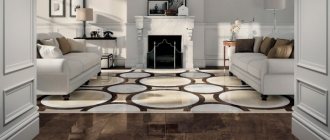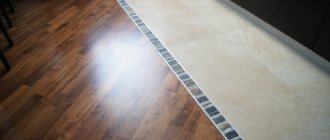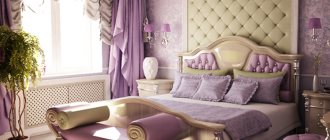Why choose floor tiles
Interior tiles produced by manufacturers are suitable for decorating walls, floors and even ceilings, but at the same time they differ in performance qualities. Home owners are faced with a difficult choice before the upcoming renovation, which depends on the drafted project.
When choosing flooring, many choose tiles for the living room floor
, considering that the use of such materials has undeniable advantages:
- extended service life if care recommendations are followed
- high level of resistance to mechanical stress and abrasion
- a huge selection of colors, sizes and shapes, materials of manufacture
It cannot be said that certain types of floor tiles have only advantages; such coatings also have disadvantages. For example, ceramic tiles can be cold and to neutralize this disadvantage, you can use floor heating systems to avoid discomfort.
Another nuance is that the surface of the coating is too smooth; tiles with a glossy finish are quite slippery, so your choice must be taken as carefully as possible.
Natural stone tiles
You can choose floor tiles from natural stone for the bathroom, hallway, living room:
More: How to combine colors in the interior
Marble and granite tiles are durable with an original pattern of soft shades. Marble tiles require careful care.
Onyx tiles, with waves and lines in the pattern, are used to decorate individual small areas of the floor.
Tiles made of velvety touch travertine are as durable as granite and marble. Colors range from soft cream shades to dark brown. Combines with wood and is not afraid of moisture.
The best types of tiles for the living room
The floor in the living room, which is constantly walked on by people, homeowners, guests, and pets, wears out quickly. When choosing a floor covering, it is important to consider all options, and if the main requirement is practicality and wear resistance, you can pay attention to the following options:
- vinyl tiles for living room;
- rubber with additional decor;
- polyvinyl chloride coating;
- quartzvenile floor tiles;
- cork tiles (natural material);
- natural stone floor tiles;
- ceramic, the most common tile.
An interesting and unusual solution would be mirror tiles in the living room interior
with a glossy and reflective coating. This option can be used in combination with other floor coverings as part of finishing or decorative elements, increasing the uniqueness of the room's interior.
Ceramics and its types
The beauty and attractiveness of the interior depends on the harmony and atmosphere of comfort, which can be created by the correct choice of all types of finishing.
The most popular combination of affordable cost and high quality is ceramic tiles, which come in different types:
- metlakhskaya, without a glazed coating and painted through;
- Cotto, with a porous structure and without enamel on the surface;
- clinker, extremely wear-resistant and not very porous in structure;
- porcelain stoneware with a glossy surface and homogeneous structure.
Almost all types of ceramic tiles are easy to care for and install, and do not collapse under prolonged exposure to chemically active substances.
To clean ceramics, you can use strong products that help clean and disinfect the surface while maintaining its attractive appearance.
Technology Features
Ceramic floor tiles for living room
when heated or supercooled, it does not emit harmful substances into the air and has no specific odor. This flooring is produced using modern technologies that differ in certain nuances of production organization:
- extrusion, forcing a plastic mass through special devices;
- pressing, for this process the charge is compacted and given the desired shape;
- monocottura, the dried mass after pressing is treated with glaze;
- bicottura, instead of glaze, high-quality enamel is used for such products.
Depending on the technology used, the finished product has its own distinctive properties. Knowing what technological process was used, you can focus on the properties acquired by the tile, which is important when choosing the best material for decorating the living room.
Tile design
In modern interiors, tiles are often found on the living room floor, photo
finished projects can be used for upcoming renovations. In this case, it is necessary to take into account the design features of the room, the style and the general concept of decorating the room.
Floor tiles in the living room
To cover the floor in the living room, special tiles are used, since ordinary tiles, for example, for the bathroom, are not suitable for this purpose.
The tiles in the living room have an increased level of strength to withstand increased loads (heavy furniture, high levels of room traffic), and have an anti-slip effect for safe movement.
Floor tiles in the living room are available in three types:
- Ceramic.
- Porcelain stoneware.
- Made from natural raw materials (stone).
It is these materials that meet established standards: they do not slip and are resistant to damage and are not susceptible to damage by chemicals (when cleaning with detergents).
Tile in the interior of the living room has long been popular in the Mediterranean countries and it is for this reason that its installation belongs to certain styles characteristic of those places:
- Mediterranean.
- Modern.
- Arab.
- Roman antiquity, which is classified as classic.
- Modern.
In our climate, the use of tiles in the living room is not very popular due to some features:
Cold. A cold floor in a home is not very comfortable, and in countries with a temperate climate, where the temperature outside the window can reach -30 degrees, the tiles will cool down very quickly.
To avoid unpleasant cold, professionals recommend equipping the floor with a heating system, but this procedure costs a lot of money and not everyone can afford.
Note! Common mistakes in apartment renovation that can be easily avoided
Hardness. Due to the increased hardness, it is not advisable to install a tiled floor in homes where there are children or elderly people, as this can be traumatic.
However, if you want tiles to be present in the living room, select a small area in front of the fireplace or a dining area for this.
The variety of tile materials in modern construction markets is amazing; there are tiles with different styles for:
- Skin.
- Textile.
- Tree.
- Marble.
It is considered a fashionable trend to use different types of layouts:
- Diagonal, to visually increase space.
- The ornament in the form of a rosette looks like an imitation of carpeting.
- Tiled mosaics will add special originality to the setting.
Laying rules and design options
Depending on the shape and size of the individual elements of the floor covering, the method of its installation is also selected. In the assortment of modern manufacturers you can also find ready-made kits, which include design projects; they are placed in the center or in the corners of the room, complemented by a background covering.
Stylistic nuances
Looking at the tile floors in the living room, photo
who are inspired to decorate their own home, you can choose the best style option.
Large or small drawings, geometric shapes and optical illusions are quite popular among modern designers.
How to understand when choosing which floor tile is better
When trying to figure out which floor tile to choose for a particular room, you need to take into account its classification, purpose, size, installation location and a number of other factors.
More: How to grow grapes
Surface . May have a glossy, matte or textured finish. Tile is slippery, especially when wet.
Thickness _ It is optimal to choose within 7-30 mm for rooms where heavy objects may fall or there is heavy furniture.
Size . The dimensions of the tiles visually affect the size of the room. Standard length is 20-120 cm, width 30-120. Most often these are square or rectangular elements. Sometimes there are polygons.
Large squares will visually make a small room even smaller; they are intended for rooms of more than 7 square meters. m. Small elements will help increase the space of the room.
Moisture resistance . For example, if you need to choose tiles for a bathroom floor, select tiles with a moisture resistance of no higher than 3%.
Resistance to chemical cleaning agents, which is indicated by the marking. The letters A and B indicate the versatility of the tile in this regard.
Additional anti-slip treatment . See mark R10-11, or numbers 1-4 and boot drawing. Slippery surface – number 1, no – number 4.
a color that is in harmony with other coatings in the room or contrasts. Light colors will brighten and expand a dark room.
Labeling . To choose the right tile for the floor, you need to pay attention to the markings: the pattern of the palm or foot. You cannot choose a box with a snowflake pattern for the floor - these tiles are for finishing outdoor surfaces.
Patterns and ornaments . For a small room, don’t choose tiles that have a lot of patterns. An original drawing, ornament or panel increases the cost of the product.
What is important to consider when choosing
When choosing high-quality and inexpensive tiles, it is necessary to take into account its environmental friendliness and compliance with sanitary requirements. The higher the porosity of the structure, the greater the likelihood of poor maintenance, but we must not forget about the appearance of the coating, because the tiles should decorate the room.
When planning an upcoming renovation, it is important not to forget about the floor covering, and if you plan to install a heated floor system, tiles will be an ideal option. It warms up well and retains heat for a long time, and in the hot season it gives coolness, decorating the room.
Photo of tiles in the living room interior
Share with friends:











